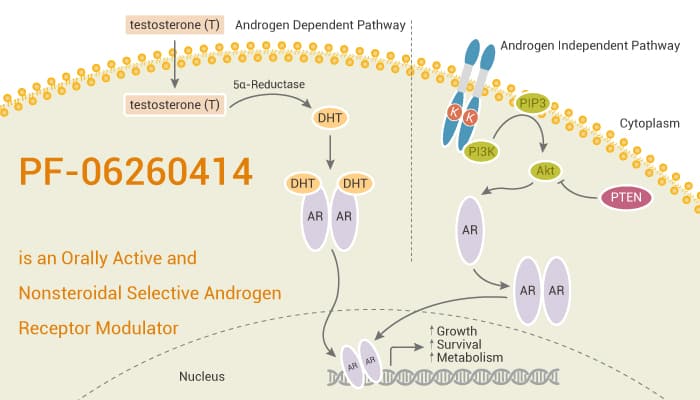The Androgen receptor (AR) is a nuclear receptor. The Androgen receptor is a DNA binding transcription factor that regulates gene expression. Specifically, androgen-regulated genes are essential for the development and maintenance of male sexual phenotypes. Besides, androgen causes slow maturation of bone, but the more effective maturation comes from estrogen produced by androgen aromatization. Moreover, The regulation of androgen receptor signaling on this integrity can be attributed to osteoblasts and osteoblasts. The main mechanism of androgen receptor action is directly regulated gene transcription. The binding of androgen to androgen receptor results in the conformational change of androgen receptor. Furthermore, it then causes the dissociation of heat shock proteins, transport from the cytosol to the nucleus, and dimerization.
Selective androgen receptor modulators (SARMs) belong to a variety of synthetic ligands. Meanwhile, they selectively bind and stimulate or inhibit androgen receptor (AR) activity in various target tissues. Nonetheless, SARM binds androgen receptors according to the chemical structure difference of each SARM. As a result, SARMs lead to anabolic cell activity while avoiding many of the side effects of anabolic steroids currently available. Here, we will introduce an orally active SARM, PF-06260414.

PF-06260414 is an Orally Active and Nonsteroidal Selective Androgen Receptor Modulator.
First of all, PF06260414 has potent AR agonist activity in a cell-based transcriptional reporter assay. Particularly, PF06260414 has a concentration of a drug that gives the half-maximal response of approximately 0.3 nM (79% efficacy vs DHT). Obviously, PF-06260414 is a partial AR agonist. PF-06260414 has the potential for muscle weakening such as that associated with muscular dystrophy and the sarcopenia associated with natural aging.
In the second place, PF-06260414 has fast absorption (median Tmax, approximately 1-2 hours), a mean t1/2 of approximately 6.9 to 12.8 hours. Interestingly, PF-06260414 had no antagonist activity in the presence of DHT. Additionally, PF-06260414 had potent AR binding but did not bind ER or MR in the presence of ER and spironolactone, respectively. PF-06260414 had weak binding to PR in the presence of PR.
All in all, PF-06260414 is an orally active and nonsteroidal selective androgen receptor modulator (SARM).
References:
Indranil Bhattacharya, et al. Clin Ther. 2016 Jun;38(6):1401-1416.